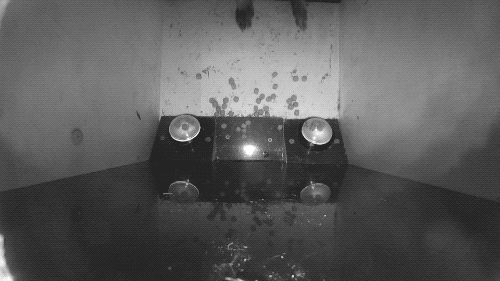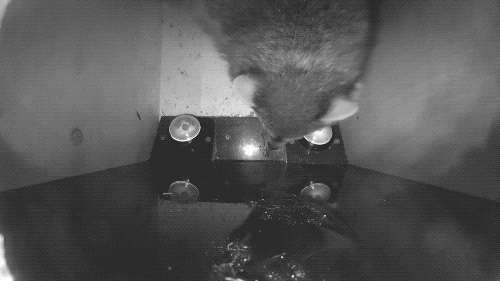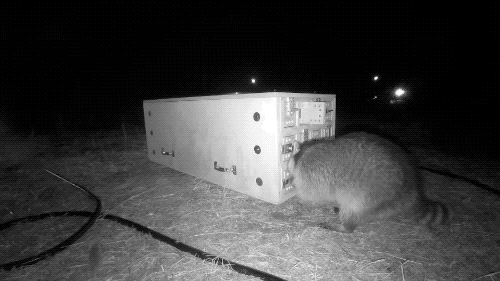Why Are Raccoons So Good At Getting Into Your Garbage?
7:45 minutes
How do raccoons keep getting into people’s trash? It might just be one of the greatest unsolved mysteries of our time. No matter what kind of fancy lid, bungee cord, or alarm system we use, somehow these masked creatures always find a way into our smelly garbage. But are they just dexterous or actually smart? Lauren Stanton, Ph.D. candidate in the Animal Behavior and Cognition Lab at the University of Wyoming, joins Ira to talk about testing the animal’s smarts. These urban dwellers are the subject of our latest Macroscope video, and you can get a peek of how they solve puzzles below.



Invest in quality science journalism by making a donation to Science Friday.
Lauren Stanton is a PhD candidate in the Animal Behavior and Cognition Lab at the University of Wyoming in Laramie, Wyoming.
[MUSIC PLAYING] IRA FLATOW: Next up, one of the great unsolved mysteries of our time– I mean, besides where did the missing socks go in the laundry– is how do raccoons keep getting into people’s trash? Have them around your house, right? No matter what kind of fancy contraption you put on that trash can– a bungee cord, an alarm system– somehow these urban dwellers always find a way into your smelly garbage.
Well, are raccoons just dexterous? Are they talented? Or are they actually smart?
That’s what one scientist wanted to know. Her work is the subject of our latest Macroscope video and she joins us now. Lauren Stanton is a PhD candidate in Animal Behavior and Cognition Lab at the University of Wyoming and she’s here with us in New York. Welcome to Science Friday.
LAUREN STANTON: Hi, Ira. Thanks for having me.
IRA FLATOW: So how smart are the raccoons?
LAUREN STANTON: [LAUGHS] That’s a great question and that’s something that we are trying to investigate in our research. You know, in our research we’ve seen that raccoons are able to solve novel problems that they’ve never experienced before. We have found that they are able to solve problems in a variety of different ways, which really speaks to their cognitive flexibility. And we see that they solve problems in ways we don’t always expect. And I think that really speaks to their creativity and their cleverness, as well.
IRA FLATOW: And so why study a raccoon? Why pick them out?
LAUREN STANTON: Sure, so our lab is really interested in the evolution of animal cognition and understanding how certain cognitive abilities, like learning and problem solving, can aid animals in adaptation to environmental disturbance like urbanization, for example. So my advisor, Dr. Sarah Benson-Amram, who is the PI of our project, she saw raccoons as a really great opportunity to get at these questions. They’re highly successful and adaptive. They have expanding ranges. They’re invasive in many parts of Europe and Japan.
And so they’re a really good system to try to look at cognition. We also know they have this reputation for being really clever, and there’s a lack of information on their cognition. So that’s kind of why we want to get at this question using them.
IRA FLATOW: I was watching the video, Macroscope video on our website at sciencefriday.com/raccoons. And I was very impressed. And you said you were out there in the forest and set up– explain to our listeners what kind of situation you set up for them to figure that out.
LAUREN STANTON: Sure, absolutely, we do a couple of different things. One of the experiments that we do is using a puzzle box that has a series of latches on it and the raccoons have to figure out how to open the puzzle box in order to get a food reward. So we use sardines and dog kibble– and that’s really enticing to them. And so by opening these different doors– the box has many doors on it– so when they open these series of doors, we can measure how long it takes them to solve and what kind of behaviors they use. And this allows us to quantify their learning ability and their cognitive flexibility.
I’ve also been using a new device that’s called– it’s kind of a throwback to an old-school Skinner box. So if you think about rats pushing levers and if they push the right lever they get a reward. If they push the wrong lever they get a shock or some type of negative stimuli. We’re not doing that in this case. They get a small time-out.
But we’ve built these boxes that have these scanners in them that allow us to identify the raccoons. They come into the box and they can push buttons to get rewards. So using this box we can look at the reversal learning. So when we teach them one reward contingency and we change it, can they adapt their behavior and learn a new reward contingency?
IRA FLATOW: When you mentioned Skinner box, I remember when I was in college when BF Skinner was very big and–
LAUREN STANTON: Oh, nice.
IRA FLATOW: –he had a contemporary named Konrad Lorenz, who thought you can’t really learn anything by being in a laboratory situation about the native intelligence. You have to go out in the wild and watch them outside. Do you think that outside– can you monitor them in their native habitat without going to your boxes at all and learn something different, do you think?
LAUREN STANTON: Well, yes, I mean, we’re really interested in studying cognition in the wild. And so as you’ve seen the video that’s on your website, we PIT tag all of our raccoons. So that’s kind of like a microchip you’d use for a dog or a cat. And when we set up our study sites, we have these scanners in place that allow us to identify the animals.
So we’re using modern technology to be able to take these studies with more traditional studies of cognition into the field and study raccoons that are wild and free-ranging. And we’re hoping that this lets us get more at their authentic cognition and because they’re exposed to all of these selection pressures happening right now. And so we want to take that snapshot and really be able to study them in their more natural environment, which, in this case, is urbanized places.
IRA FLATOW: I’m Ira Flatow. This is Science Friday from WNYC Studios. Talking with Lauren Stanton, who is studying raccoons in the wild. And her project is the subject of our Macroscope video at sciencefriday.com/raccoons. What was the smartest thing you saw them do?
LAUREN STANTON: I’ve seen– they’ve blown me away in a couple of cases. What really impresses me is raccoons’ ability to cheat. It seems like no matter what kind of puzzle I give them, they always behave in ways that I didn’t necessarily predict.
So we did try giving them a touchscreen in captivity with our collaborators at the USDA. And what we found was that when we gave them this touchscreen, and they had to pick one side of the touchscreen in order to get a reward, instead of following the cues we were giving them, they would just keep their paw on the screen and be watching the food hopper where the food would come out. And they would just push randomly, and 50% of the time they were bound to get it right because of the way we had designed the program.
So instead of them paying attention to the signals and cues we were using, they just found their own way to interact with the device. So that’s when we decided to take a step back and say, OK, let’s get a bit more old-school. Let’s go back to just two buttons and see what they do with those.
IRA FLATOW: Were they able to teach other raccoons how to work the boxes on the screen?
LAUREN STANTON: That’s a great question and also something we’re looking at. We’re really interested in social learning. Colleagues and I at the University of Wyoming are building social networks based off of our puzzle box data and trying to look at whether or not these raccoons were learning solutions from one another. So, hopefully, I’ll have a better answer for your question in the future.
IRA FLATOW: So you have much more field work to do, have you?
LAUREN STANTON: I do, I do. Well, we have more data analysis and video coding to do from previous experiments. And then we also have, yes, some more field experiments that are going to take place. And this is a long-term project in our lab. We’re hoping that raccoons are going to remain our study system for these types of questions.
IRA FLATOW: Any hope for we people who have them coming to our garbage can? What do you do? What do you, Lauren? What’s the best way to keep them out, do you think?
LAUREN STANTON: Oh, you know, I think that constantly just changing up your mechanisms is probably a good idea. There is a chance that they’re just going to continue to keep learning every time we put out a challenge for them. There’s a chance they’re going to be able to overcome it.
IRA FLATOW: Are we making them smarter by just giving– do they look at these as puzzles and say, oh, I got something new to learn here?
LAUREN STANTON: That is certainly a possibility. Up in Toronto, I don’t know if you saw this, but they’ve outfitted the city in these raccoon-resistant trash bins. And everybody was saying there’s no way they’re going to be able to get into them. And I don’t know for sure what’s going on up there. Suzanne MacDonald, who’s a researcher at York, probably knows all the ins and outs.
But there was an article in the Toronto Star recently saying that the raccoons are slowly starting to figure out how to open these trash bins. So, I mean, it could very well be that we’re at this evolutionary arms race with raccoons. And the more challenges that we put out in the environment, the more we try to prevent them from getting in, the more they’re going to figure out how to get in. So, yeah, another good question for us to look at.
IRA FLATOW: Fascinating work, Lauren. Lauren Stanton, PhD candidate in Animal Behavior and Cognition at the University of Wyoming, and her work is the subject of our latest Macroscope video. This is a really cool one. It’s on our website at sciencefriday.com/raccoons. Thank you for being with us today.
LAUREN STANTON: Thank you, Ira.
Copyright © 2018 Science Friday Initiative. All rights reserved. Science Friday transcripts are produced on a tight deadline by 3Play Media. Fidelity to the original aired/published audio or video file might vary, and text might be updated or amended in the future. For the authoritative record of Science Friday’s programming, please visit the original aired/published recording. For terms of use and more information, visit our policies pages at http://www.sciencefriday.com/about/policies/
Katie Feather is a former SciFri producer and the proud mother of two cats, Charleigh and Sadie.